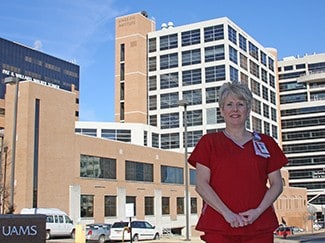Cornea Transplant Patient Grateful for Donor

Lisa Holt received a cornea from the Arkansas Lions Eye Bank and Laboratory at UAMS.
| March 19, 2015 | Lisa Holt thinks about the family of her eye donor every March — National Eye Donor Month — and is grateful.
“His family gave a total stranger the gift of sight. That truly is remarkable,” she said.
Holt, from Lonoke, is no stranger to eye problems. She started wearing glasses in the second grade and contacts in the fifth grade. Then, in 1995 at age 26, she began noticing changes in her left eye. She described it as having a water balloon over her eye.
As a radiology student at UAMS, Holt had trouble doing simple classroom tasks.
“If I had a tube I needed to put a clamp on, with both eyes open I would miss the tube because of the way my cornea bulged out and watered a lot,” she said. “I would have to close my left eye.”
In 1995, Holt was diagnosed with an aggressive type of keratoconus by an ophthalmologist. Keratoconus is a progressive eye disease in which the normally round cornea of the eye thins and begins to bulge into a cone-like shape. This curve causes astigmatism and nearsightedness. It usually affects both eyes, but in Holt’s case, it only affected the left eye.
Holt was referred to a cornea specialist, but sought a second opinion from an ophthalmologist at the UAMS Harvey and Bernice Jones Eye Institute and the John L. McClellan Memorial Veterans Hospital.
Holt was fitted with three types of contacts to reduce her astigmatism and to delay surgery, but none of the options worked because of the bulge in the cornea.
“If you looked at my face from the side, you could see the soft contact sitting on my eyelash — that’s how bad it was,” she said.
Holt was put on the cornea transplant waiting list at the Arkansas Lions Bank and Laboratory at UAMS. A week later, she was notified that she had a cornea donation from a 15-year-old male.
Holt said the surgery went smoothly.
“During surgery the ophthalmologist actually let my sister go in with me and she held my hand all the way through the surgery,” she said. “I really had no trouble at all. I had a few days where I didn’t feel that well, but most of it was a relaxing six weeks off.”
The year after her surgery, Holt said her eye started showing signs of rejecting the transplant.
“JEI increased my steroid shots and pulled me out of it within just a couple of weeks, and I was back to being fine,” she said.
Today, Holt’s doctors say her cornea is “wonderful.” However, there are signs that Holt’s keratoconus is starting to reoccur around the outer edge of the cornea.
“So long as the contact continues to fit, I won’t have to have surgery for several years,” she said.
Holt’s transplant not only changed her vision, but it changed her friends’ minds about eye and organ donation.
“After my cornea transplant, I know several of my friends who became organ donors,” she said. “That meant a lot. I sure became a donor, as well.”
Arkansas Lions Eye Bank, the only eye bank in Arkansas, was established in 1986 and obtains, prepares and delivers eye tissue to transplanting surgeons all over the state and occasionally across the country and around the world.
Every year since 2010, the bank has collected tissue for around 400 cornea transplants.
Geoff Brown, executive director of the eye bank, encourages people to consider becoming an eye donor.
“There’s always going to be a need,” Brown said. “When you donate, most corneas are going to directly help other Arkansans.
For information on eye donation, visit http://eye.uams.edu/arkansas-lions-eye-bank-lab/.